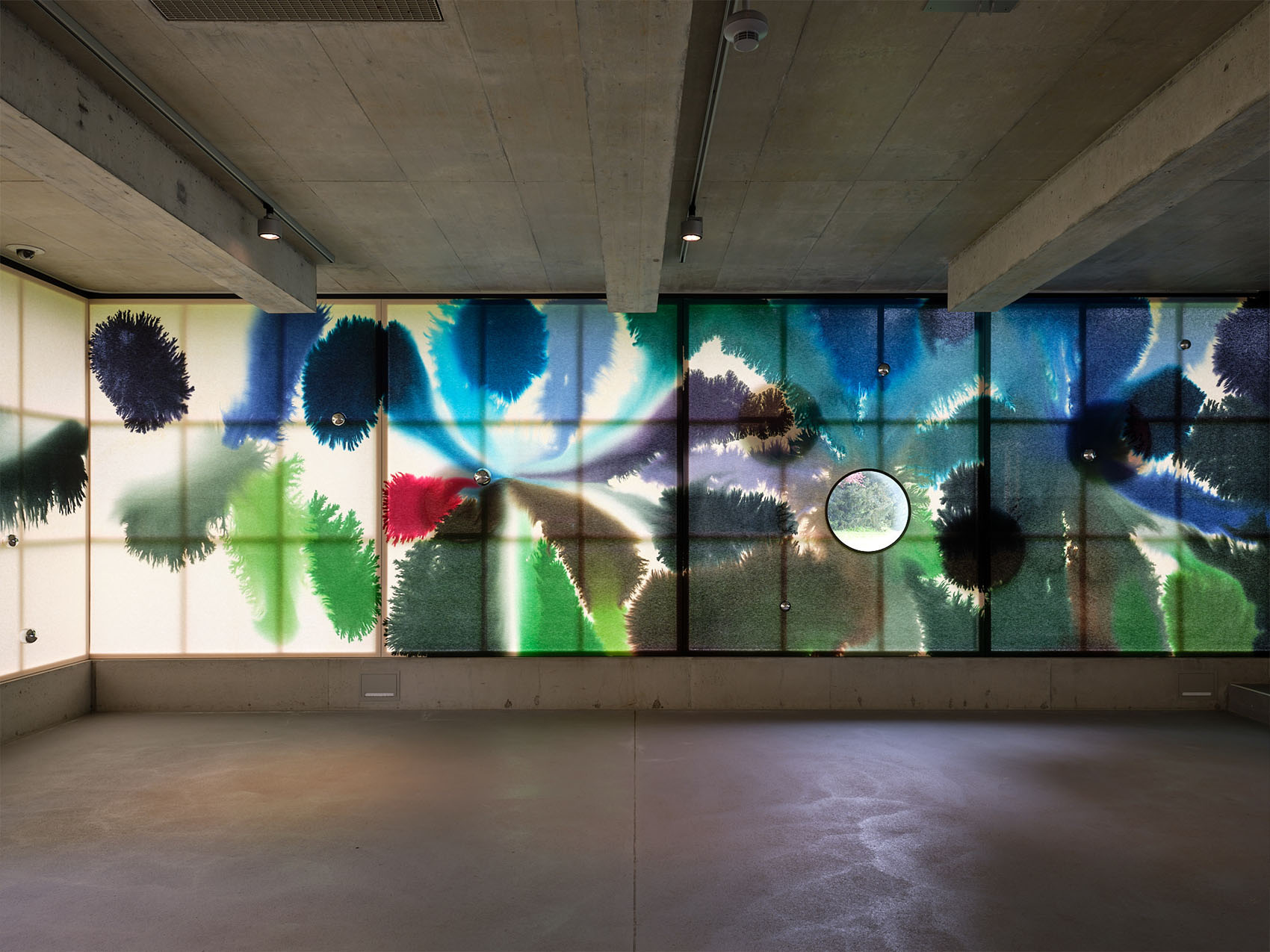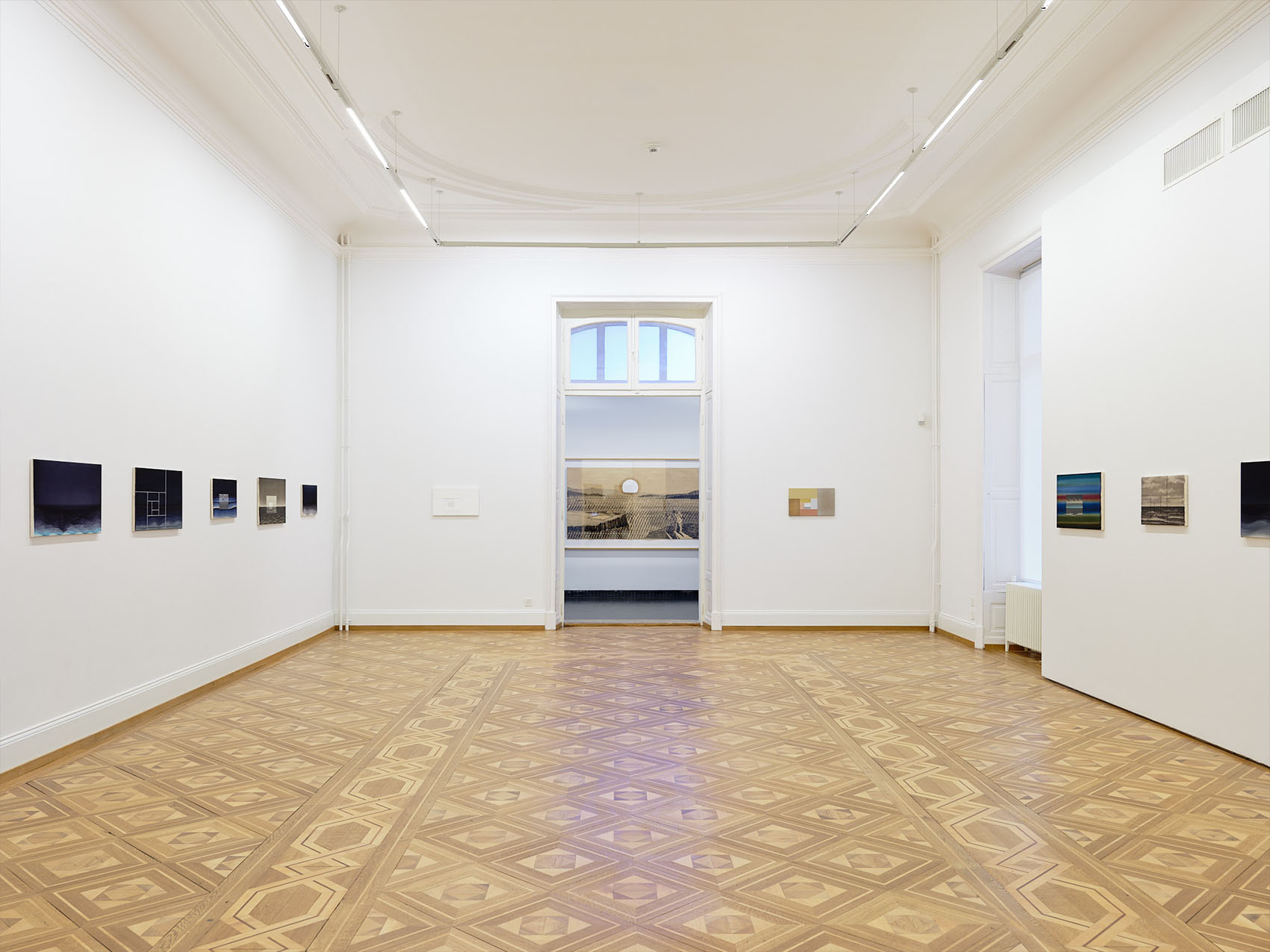
The Art Philosopher GIACOMO SANTIAGO ROGADO
Thun, Switzerland – It’s a rainy day, and the Schadaupark in Thun is empty. Nothing seems to be out of the ordinary. However, the reason why our team are at the park is not because of the usual. We are visiting the Thun Panorama, which, for the first time in its history, is extending an exhibition hosted by the Kunstmuseum Thun. It is the exhibition of the Luzern-born artist Giacomo Santiago Rogado. He is one of the most renowned Swiss artists alive and has created an exhibition tailored for the Kunstmusem and the Thun Panorama‘s spaces.
The Thun Panorama is a building that merges smoothly into the surrounding park through its architecture and colours. While the original part of the building is recognisable through its round brick walls, the new building extension from 2014 is known for its glass façade giving the concrete roof an almost floating appearance. Rogado used these factors, and with his canvas, he created a piece of art that plays with them, giving the building a new character within the interior and exterior. As Rogado stated, “It is not an easy space to work in, as it consists mainly of windows.” Looking at his final result, we can tell that every corner is thoroughly thought through. The artist used the windows as a tool that, on one hand, allows a sneak peek from the outside into the installation and, on the other hand, plays with the sunlight. Having directly covered the glass with canvases, the in and outcoming light reveals their structure, exactly as the architect of the building did through the materials chosen, giving the space a new face. With the sun shining past the canvas, the colours on it change the light and atmosphere of the room. Through round holes in the “painting” aligned to all four celestial directions, framing the outside landscape, the viewer is surrounded by an interplay of manmade art and the art of nature. Furthermore, as the canvas openings are quite small, only defined parts of the view are visible, making the framed look almost abstract. This allows a balanced interplay between the colours and shapes on the canvas with the given space. To further extend this 360-degree feeling, slight, mirrored globes reflect everything around them, offering another dimension. The sum of these different elements makes the shown more of an art installation than a painting. The atmosphere is unique to the space and changes throughout the days and seasons due to the changing climate, making it worth several visits!

Ausser Sicht, 2024
Installation
Mixed technique on cotton
250 x 3100 cm
One now may wonder how an installation that depends so heavily on the light and surroundings provided by the Thun Panorama can be a continuation of the Kunstmuseum. The museum’s curation focuses on the different stages Rogado went through during his career as an artist, underlining his preference for process-oriented work. While the result is obviously a relevant part of the process, he tends to focus much more on the steps it takes to get to the final piece, how art can impact its surroundings and vice versa.
To give an idea of the exhibition’s flow, we start with the paintings that mark the origin of this collaboration. The first room presents three paintings: Bellevue 1+2 and Lucia on permanent loan at the Kustmuseum Thun. They each show a person painted on a sepia-coloured background with black oil paint. The man and the two women portrayed are all wearing a debardeur (vest) that seems almost like the opening to another dimension, revealing a horizon with clouds in the sky over a never-ending sea painted with white and grey oil paint and a rougher ductus than the rest of the portraits. The three people seem to be interacting with each other across the borders of the paintings. The room introduces us to Rogado’s vision of capturing the endless, framing it and giving us a lead through the exhibition.

Bellevue 1+2, 2007
Acryl, oil on linen
120 x 90 cm
The next room contains a variety of small paintings that show different versions of endless horizons. Interestingly, the artist guides us from very abstract interpretations of this idea by referencing the spirals of the famous mathematician Fibonacci to carefully painted versions of the horizons, which repeat themselves within their continuation. This room introduces its visitors to Giacomo Santiago Rogado’s previously mentioned process-oriented approach by demonstrating his visions through different formats.

Room two at the Kunstmuseum Thun.
After this room, the visitors can choose how to continue the exhibition. One way to go is through an open arched door, revealing another art installation whose structure reminds of the display at the Thun Panorama. It is an installation that looks like a huge box with the backs of large canvases facing the outside. These backs show large, leaked colour patches, giving the idea that more must be on the canvas’ front side. Rogado had an interactive idea to reveal these front parts by passing through a little black corridor full of black curtains leading the way to the inside box. Once in, we find ourselves in a room made of canvas. The light comes from the outside room and is filtered by the fabric of the paintings. We see paintings made with a similar technique as the ones at the Thun Panorama. The difference here is that the canvas is also on the ceiling, which gives the impression of being inside the painting, inside the artist’s mind. It is a calm space that dampens all noises through its construction. It is a space that offers its visitors a break from the busy world and leaves space for reflection. It truly is an experience that invites us to absorb the surroundings and to experience Rogado’s art literally. As he emphasised several times, paintings to him represent a space rather than a simple canvas. With this installation, he gives the viewers an impression of this thought process.

Growing together through emotions over time, 2022
Installation
Mixed technique on cotton
300 x 400 x 600 cm
When exiting the installation, we find ourselves back in the bright light of the museum, with all the noises of the other visitors. We are back in reality. We continue the tour with the next room, which features a few paintings, mainly uni-coloured and built up on the artist’s ductus. He used a technique that leaves the paint with a deep brush structure, creating spirals and other rounded shapes. This gives the viewer the opportunity to look at the painting from different angles that are changing the face of the image. Since it is impossible to see everything at one glance, it prompts the viewer to explore the painting and forces them to interact and experience the artist’s art. This attempt continues as well in the following room. It is a room that hosts a large piece, consisting of 16 canvases with a total size of 300 x 1600 cm, Rogado has previously exhibited in other museums and is called “Anfang von Etwas” which is German and means “The beginning of something”. The rounded shape of this piece allows a 180-degree experience and could, therefore, be considered as another installation. Even though only abstract techniques were used, it is an installation that tells the story of its title through its use of colour and composition. With a large bright part in the centre, various colours are spreading from it, making it look like an explosion, comparable to how humanity explains the Big Bang. “It is important to me to let colours speak. What are they trying to tell us? I like to give them the space to flow and develop.” Rogado explained, completing the cycle of experiencing art.

Anfang von Etwas, 2021
Installation
Mixed technique on cotton
300 x 1600 cm
With some more rooms, exhibiting some of his older and younger pieces, Rogado invites us to travel with him through his creative journey. It is a journey that has evolved so much over time, yet he has stayed true to his initial idea of creating spatially tangible art. Creating something that stimulates people’s minds and perceptions. It is an exhibition that is so carefully curated, not only explaining to us the artist’s ideas, inspirations and intentions but leaving enough space for personal interpretations and thought processes.
photographer DAVID AEBI
author JON FLOYD LENZ

